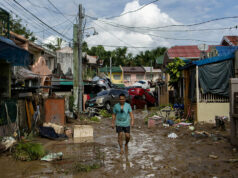Raising the alarm: the dangers of e-cigarettes
By Susan Claire Agbayani
CRÈME BRÛLÉE, custard, honey, Yakult, banana, mango, M&M, Gummy Bears, cappuccino, mint, root beer float, Coke, Sprite. Name it, they have it. From a survey of online sites alone, to date, there are over 15,500 flavorings to choose from among e-cigarettes the world over.
This was reported by Dr. Ulysses Dorotheo, Executive Director of Southeast Asia Tobacco Control Alliance (SEATCA), in his presentation to media practitioners from all over the Philippines at the forum Nagbabagang Kuwento: Reporting on E-Cigarettes and Novel Products, organized by the Probe Media Foundation, Inc. and held at the Novotel hotel last month.
Apart from this, the device usually referred to as “vape” is hip, trendy, and one can do tricks with it. Popular ABS-CBN show Pilipinas Got Talent even featured a contestant who had “vaping” as a “talent” (puffing, making circles and shapes withthe vapor, changing colors and styling bubbles) projecting “vaping and e-cigarettes (as) hip and stylish,” noted Benedict Nisperos, a legal consultant of HealthJustice Philippines, a non-government organization. As of press time, the YouTube video of the performance had garnered 38.7 million views.
MARKETING CIGARETTES, E-CIGS
Dr. Dorotheo said that e-cigarettes are being marketed the way conventional cigarettes were marketed decades ago: associating them with attractiveness, success, fun, or sex appeal, like cigarette companies used the image of a rugged man astride a horse, or a macho man surrounded by many women in a disco.
The difference is the use of social influencers to help push the products today. Media organization Reuters got wind of this, and exposed it, forcing Phillip Morris to suspend its social influencer campaign.
Although already banned in 43 countries — including very recently, India — e-cigarettes have definitely been targeted to the youth as a trendy product, with e-cig brands going around “campuses sponsoring sports events, prom nights, and introducing these products to these kids’ events,” noted Mr. Nisperos.
Until recently there were 107 pro-smoking apps available on smartphones. But just a few weeks ago, Apple removed the vaping apps according to CNBC, thanks to the current spate of lung illness in the US which has been linked to vaping. (https://www.cnbc.com/2019/11/15/apple-removes-vaping-related-apps-from-app-store-amid-lung-illness-crisis.html)
“[A] survey of teenagers in the US, (found out that) 12-13 % thought that they were just vaping flavours,” said Dr. Dorotheo. “Hindi nila alam na may nicotine (they did not know that it had nicotine). By the time they found out, they were already addicted to it. That’s a big problem. Time magazine covered it — how [the most popular e-cigarette brand] hooked kids — and ignited a public health crisis. (It is the) new American addiction,” he said. (https://www.nbcnews.com/health/health-news/more-teens-are-vaping-many-think-it-s-nicotine-free-n948251)
In an informal survey, Dr. Riz Gonzalez, who regularly conducts in public for a especially among young people, said she found out that what lures young people to “vaping” are, in this order, flavorings, media, and friends.
Dr. Gonzalez is the chair of the Tobacco Control Advocacy Group of the Philippine Pediatric Society. Fresh from a trip to the US where she attended the 2019 American Academy of Pediatrics (AAP) National Conference (she is a member of the Section of Tobacco Control of AAP), she was one of the resource speakers at the Probe forum. Her segment was titled “Are E-cigarettes Really SafeR?”
Dr. Gonzalez is one of those who try to spread awareness regarding e-cigarettes so that this “impending epidemic among children will not happen like what is happening in the United States.”
According to updated figures from the Centers for Disease and Control Prevention as of Nov. 20, 2,290 cases of e-cigarette or vape-associated lung injury (EVALI) have been reported in 49 states — including 47 deaths in 25 states — in the United States. (https://www.cdc.gov/tobacco/basic_information/e-cigarettes/severe-lung-disease.html?fbclid=IwAR3X4Hvhaa30MiqDZGIFmweDTh0u91ge_ALuqQrLuKijYzNYwt82fxypct8)
AEROSOL, NOT VAPOR
The CDC website notes that electronic cigarettes (or e-cigarettes) “are also called vapes, e-hookahs, vape pens, tank systems, mods, and electronic nicotine delivery systems (ENDS)” and that using an e-cigarette product is commonly called “vaping.” The site added that e-cigarettes work “by heating a liquid to produce an aerosol that users inhale into their lungs.
And this aerosol does not contain what users think it does. “E-cigarettes create an aerosol by using a battery to heat the e-liquid. Users inhale this aerosol into their lungs. When you heat it — the humectants, flavoring, nicotine, interact with nickel, lead, and tin from the coils adding up metallic nano-particles from this device,” Dr. Gonzalez said.
She added that “We should never call it a vapor; that’s actually a misnomer, because vapor is plain water produced after heating; aerosol is the proper term.”
Mr. Gonzalez said that second-hand aerosol (SHA) “might be less [dangerous] than that of second-hand smoke (SHS), but it still contains those particles which can impair lung function and development in the young.”
“No amount of scrubbing” will remove third-hand aerosol (THA) said Dr. Gonzalez. “Chemicals stick to bathroom tiles being hygroscopic or water loving.” She added that it also reacts upon exposure to air, and when oxidized turns into potential carcinogen (nitric oxide).
THE EVOLUTION OF THE E-CIG
An American national named Helbert Gilbert designed the first e-cigarette way back in 1963. It never prospered though.
Forty years later, a 52-year-old pharmacist from Beijing, China, Hon Lik, invented the modern e-cigarette. It had to “mimic the stick, mimic the cloud, and this hand-to-mouth habit,” said Dr. Gonzalez. The e-cigarette was finally launched to the public in 2006.
While only a “teenager” by today’s standards (at 13 years old), e-cigarettes have evolved: from the first-generation cig-alike in 2007, to the tank system with more e-liquid in 2009, and from mods that looked like cell phones (and could explode, by the way) in 2012, to the pod system of today. The nicotine content of one pod is equivalent to at least one pack of cigarettes, although flavors like crème brûlée could contain nicotine equal two packs.
The most popular e-cigarette brand in the US is Juul (after “jewel”) which has captured 70% of the market (thus, the new verb, “juuling”). It launched in the Philippines in June this year and its local competitor is Relx.
This e-cig has a “discreet aerosol (not a large cloud), doesn’t smell like cigarettes, is easy to hide because it resembles a flash drive, has assorted flavours that come in pre-packaged pods, and could be charged like a USB stick,” Dr. Dorotheo said.
How the pods look should raise alarm bells among parents. They are so small they could be concealed as USBs, under sleeves, in smart watches, and in “strings” of hoodies. That is according to Dr. Dorotheo’s presentation (Google “Vape wearables”). And it doesn’t help at all that pods are sometimes displayed prominently without warnings in convenience stores — right beside the candies — and the age of the buyer is not thoroughly examined by store crew.
“Consuming tobacco products is like falling from the 20th floor of a building, while using e-cigs is like falling from the 10th floor. Either way, it harms you,” Ira Camarao, Project Manager of the Strategy, Economics and Results Group of the Department of Finance (DOF), said during the forum, as stated by the WHO representative in one of the Senate hearings last September.
BANNING CIGARETTES AND VAPES
It is also alarming that in the Philippines, one in five users of e-cigarettes or vapes is below the age of 20, according to the Food and Nutrition and Research Institute (FNRI).
Dr. Riz Gonzalez says that adolescence is a time of “risk taking, when you want something pleasurable, you’re mighty in the family, [you] don’t want to listen to parents, but listen more to your peers.” Dr. Gonzalez is the chair of the Tobacco Control Advocacy Group of the Philippine Pediatric Society.
Because adolescents are the way they are, they are particularly susceptible to the e-liquids or e-juices, which contain humectants, flavorings and nicotine. Flavors play a role in nicotine addiction by young people, whose brain chemistry is malleable and still maturing, said Dr. Gonzalez.
She added, “The developing brain matures by age 25, not 18, based on recent findings.”
Nicotine, she said, “is the number three (most) highly addictive substance in the world. If you can manipulate the humectants (propylene glycol and vegetable glycerin) you can also manipulate the dose of nicotine from zero to 36 mg. The normal (nicotine content in) cigarette is 20 milligrams [per pack]. See? So para kang nagpunta ng café (it is as if you went to a café where) you can ask for more cream and sugar.”
Exposure to nicotine during adolescence has “long-standing effects in the brain, including cell damage that leads to both immediate and persistent behavior changes,” said Dr. Gonzalez. “Nicotine from smoking/vaping changes the brain chemistry. Nicotine uses the dopamine reward pathway.”
So when young people start smoking cigarettes or e-cigarettes when they’re 18 (or any age under 25), it’s harder for them to quit because the brain has been rewired for nicotine addiction.
These effects, she added, “are not found with nicotine exposure to the adult, supporting the idea that the adolescent brain is uniquely susceptible to nicotine addiction.”
Dr. Gonzalez mentioned that “Like a CEO, the pre-frontal cortex is responsible for executive function. It controls your mood, your attention span, your behavior, cognition, impulse, emotions and higher learning.” It also has “jurisdiction” over organization, planning, self-control, and judgment.”
The long-term effects of nicotine exposure during adolescence include diminished cognitive function as adults, reduced attention span, enhanced mood alterations such as anxiety or depression.
Among the other health risks for vapers are: lung cancer, cardiovascular diseases, and myocardial infarction.
While decades ago, smokers had problems or died in their 50s or 60s, she noted that the patients are getting “younger and younger.”
“Dapat, ang emphysema pang 60-years old lang (emphysema should just be a problem for 60 year olds). For chronic vapers, emphysematous change could happen in the young because of that heated aerosol that they are taking in. We will not be surprised if in two to five years, we’ll be seeing children vapers having a heart attack because of all this exposure,” said Dr. Gonzalez.
And while pneumonia used to be the No. 1 killer in the country, a host of patterns of lung injury have been reported with vaping-associated pulmonary illness (VAPI) such as acute eosinophilic pneumonia, lipoid pneumonia, acute lung injury, acute and subacute hypersensitivity pneumonitis, diffused alveolar haemorrhage, and respiratory bronchiolitis-associated pneumonitis, among others.
In the local scene, “The Department of Health (DOH), in line with the WHO’s ICD-10 reporting of diseases, announced last Oct. 17 to report EVALI (e-cigarette or vape-associated lung injuries) as a reportable disease,” said Dr. Dorotheo.
He added that they are now receiving reports from doctors who are saying that some of their vaper-patients have coughs, and respiratory and heart problems. And doctors are starting to see “it” (meaning the diseases associated with vaping). It won’t take long till the Philippines will come up with its own figures.
Benedict Nisperos, a legal consultant of the NGO HealthJustice Philippines, said, “We are very interested in the US (because what is happening there) can happen in the Philippines. At this juncture, we can work together and propose policies that would prevent this epidemic from happening in the Philippines.”
“We have young people being fed this misinformation, that e-cigarettes are OK; they’re not bad at all. It’s an alternative [to cigarettes]; it’s safer,” said Dr. Dorotheo. “Given what we already know about its health effects, it’s as if we’re dooming our next generation to being sick, disabled, and dying early. In the case of the US, those who are being hospitalized and (are) dying early are in their teens, 30s, 40s, very productive; and the oldest in their 60s or 70s.”



